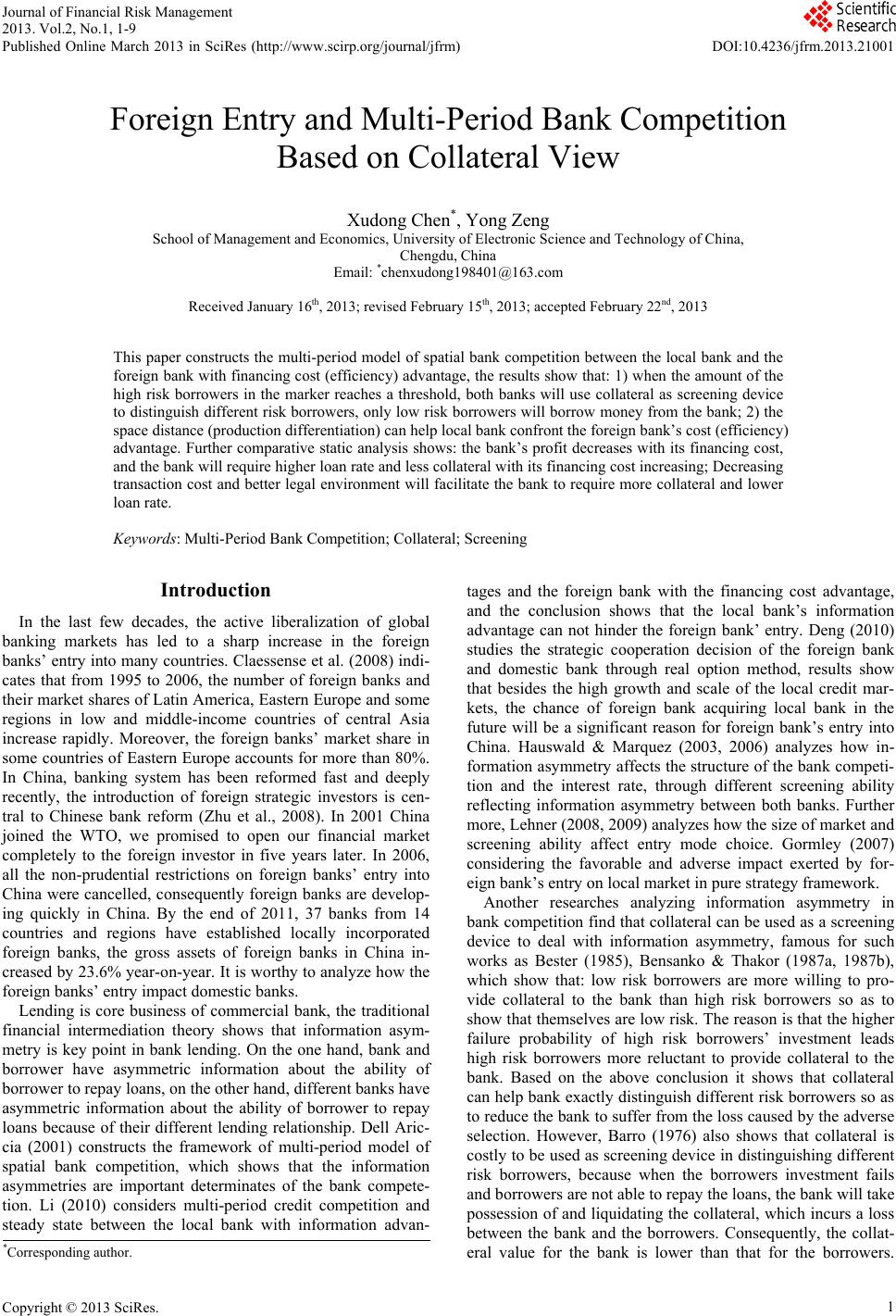 Journal of Financial Risk Management 2013. Vol.2, No.1, 1-9 Published Online March 2013 in SciRes (http://www.scirp.org/journal/jfrm) DOI:10.4236/jfrm.2013.21001 Foreign Entry and Multi-Period Bank Competition Based on Collateral View Xudong Chen*, Yong Zeng School of Management and Economics, University of Electronic Science and Technology of China, Chengdu, China Email: *chenxudong198401@163.com Received January 16th, 2013; revised February 15th, 2013; accepted February 22nd, 2013 This paper constructs the multi-period model of spatial bank competition between the local bank and the foreign bank with financing cost (efficiency) advantage, the results show that: 1) when the amount of the high risk borrowers in the marker reaches a threshold, both banks will use collateral as screening device to distinguish different risk borrowers, only low risk borrowers will borrow money from the bank; 2) the space distance (production differentiation) can help local bank confront the foreign bank’s cost (efficiency) advantage. Further comparative static analysis shows: the bank’s profit decreases with its financing cost, and the bank will require higher loan rate and less collateral with its financing cost increasing; Decreasing transaction cost and better legal environment will facilitate the bank to require more collateral and lower loan rate. Keywords: Multi-Period Bank Competition; Collateral; Screening Introduction In the last few decades, the active liberalization of global banking markets has led to a sharp increase in the foreign banks’ entry into many countries. Claessense et al. (2008) indi- cates that from 1995 to 2006, the number of foreign banks and their market shares of Latin America, Eastern Europe and some regions in low and middle-income countries of central Asia increase rapidly. Moreover, the foreign banks’ market share in some countries of Eastern Europe accounts for more than 80%. In China, banking system has been reformed fast and deeply recently, the introduction of foreign strategic investors is cen- tral to Chinese bank reform (Zhu et al., 2008). In 2001 China joined the WTO, we promised to open our financial market completely to the foreign investor in five years later. In 2006, all the non-prudential restrictions on foreign banks’ entry into China were cancelled, consequently foreign banks are develop- ing quickly in China. By the end of 2011, 37 banks from 14 countries and regions have established locally incorporated foreign banks, the gross assets of foreign banks in China in- creased by 23.6% year-on-year. It is worthy to analyze how the foreign banks’ entry impact domestic banks. Lending is core business of commercial bank, the traditional financial intermediation theory shows that information asym- metry is key point in bank lending. On the one hand, bank and borrower have asymmetric information about the ability of borrower to repay loans, on the other hand, different banks have asymmetric information about the ability of borrower to repay loans because of their different lending relationship. Dell Aric- cia (2001) constructs the framework of multi-period model of spatial bank competition, which shows that the information asymmetries are important determinates of the bank compete- tion. Li (2010) considers multi-period credit competition and steady state between the local bank with information advan- tages and the foreign bank with the financing cost advantage, and the conclusion shows that the local bank’s information advantage can not hinder the foreign bank’ entry. Deng (2010) studies the strategic cooperation decision of the foreign bank and domestic bank through real option method, results show that besides the high growth and scale of the local credit mar- kets, the chance of foreign bank acquiring local bank in the future will be a significant reason for foreign bank’s entry into China. Hauswald & Marquez (2003, 2006) analyzes how in- formation asymmetry affects the structure of the bank competi- tion and the interest rate, through different screening ability reflecting information asymmetry between both banks. Further more, Lehner (2008, 2009) analyzes how the size of market and screening ability affect entry mode choice. Gormley (2007) considering the favorable and adverse impact exerted by for- eign bank’s entry on local market in pure strategy framework. Another researches analyzing information asymmetry in bank competition find that collateral can be used as a screening device to deal with information asymmetry, famous for such works as Bester (1985), Bensanko & Thakor (1987a, 1987b), which show that: low risk borrowers are more willing to pro- vide collateral to the bank than high risk borrowers so as to show that themselves are low risk. The reason is that the higher failure probability of high risk borrowers’ investment leads high risk borrowers more reluctant to provide collateral to the bank. Based on the above conclusion it shows that collateral can help bank exactly distinguish different risk borrowers so as to reduce the bank to suffer from the loss caused by the adverse selection. However, Barro (1976) also shows that collateral is costly to be used as screening device in distinguishing different risk borrowers, because when the borrowers investment fails and borrowers are not able to repay the loans, the bank will take possession of and liquidating the collateral, which incurs a loss between the bank and the borrowers. Consequently, the collat- eral value for the bank is lower than that for the borrowers. *Corresponding author. Copyright © 2013 SciRes. 1 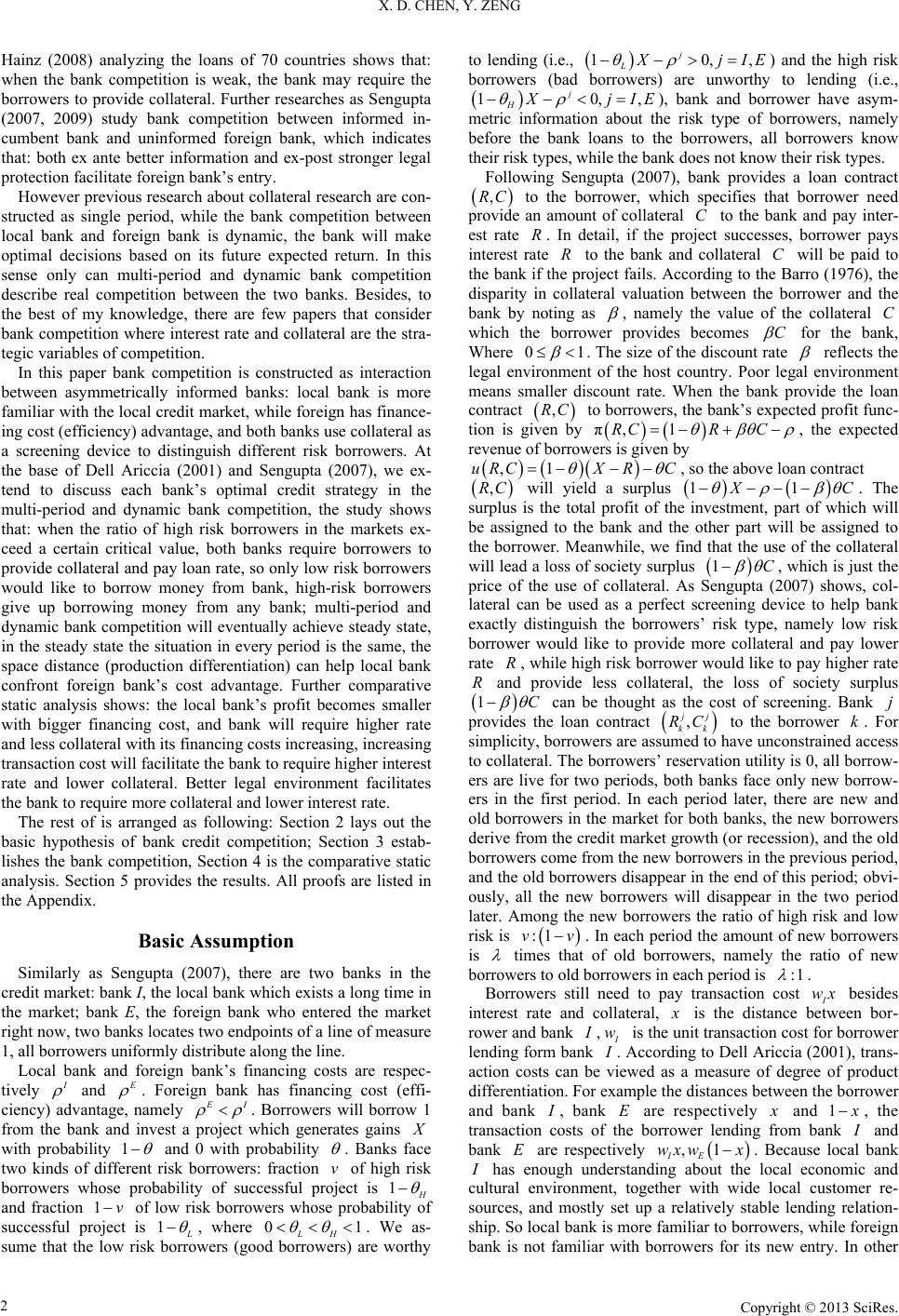 X. D. CHEN, Y. ZENG Hainz (2008) analyzing the loans of 70 countries shows that: when the bank competition is weak, the bank may require the borrowers to provide collateral. Further researches as Sengupta (2007, 2009) study bank competition between informed in- cumbent bank and uninformed foreign bank, which indicates that: both ex ante better information and ex-post stronger legal protection facilitate foreign bank’s entry. However previous research about collateral research are con- structed as single period, while the bank competition between local bank and foreign bank is dynamic, the bank will make optimal decisions based on its future expected return. In this sense only can multi-period and dynamic bank competition describe real competition between the two banks. Besides, to the best of my knowledge, there are few papers that consider bank competition where interest rate and collateral are the stra- tegic variables of competition. In this paper bank competition is constructed as interaction between asymmetrically informed banks: local bank is more familiar with the local credit market, while foreign has finance- ing cost (efficiency) advantage, and both banks use collateral as a screening device to distinguish different risk borrowers. At the base of Dell Ariccia (2001) and Sengupta (2007), we ex- tend to discuss each bank’s optimal credit strategy in the multi-period and dynamic bank competition, the study shows that: when the ratio of high risk borrowers in the markets ex- ceed a certain critical value, both banks require borrowers to provide collateral and pay loan rate, so only low risk borrowers would like to borrow money from bank, high-risk borrowers give up borrowing money from any bank; multi-period and dynamic bank competition will eventually achieve steady state, in the steady state the situation in every period is the same, the space distance (production differentiation) can help local bank confront foreign bank’s cost advantage. Further comparative static analysis shows: the local bank’s profit becomes smaller with bigger financing cost, and bank will require higher rate and less collateral with its financing costs increasing, increasing transaction cost will facilitate the bank to require higher interest rate and lower collateral. Better legal environment facilitates the bank to require more collateral and lower interest rate. The rest of is arranged as following: Section 2 lays out the basic hypothesis of bank credit competition; Section 3 estab- lishes the bank competition, Section 4 is the comparative static analysis. Section 5 provides the results. All proofs are listed in the Appendix. Basic Assumption Similarly as Sengupta (2007), there are two banks in the credit market: bank I, the local bank which exists a long time in the market; bank E, the foreign bank who entered the market right now, two banks locates two endpoints of a line of measure 1, all borrowers uniformly distribute along the line. Local bank and foreign bank’s financing costs are respec- tively and . Foreign bank has financing cost (effi- ciency) advantage, namely I . Borrowers will borrow 1 from the bank and invest a project which generates gains with probability 1 and 0 with probability . Banks face two kinds of different risk borrowers: fraction of high risk borrowers whose probability of successful project is 1 v and fraction of low risk borrowers whose probability of successful project is 1 1v , where LH 01 . We as- sume that the low risk borrowers (good borrowers) are worthy to lending (i.e., 10, j L, jIE ) and the high risk borrowers (bad borrowers) are unworthy to lending (i.e., 1 j H0,, jIE ), bank and borrower have asym- metric information about the risk type of borrowers, namely before the bank loans to the borrowers, all borrowers know their risk types, while the bank does not know their risk types. Following Sengupta (2007), bank provides a loan contract , C to the borrower, which specifies that borrower need provide an amount of collateral to the bank and pay inter- est rate C . In detail, if the project successes, borrower pays interest rate to the bank and collateral will be paid to the bank if the project fails. According to the Barro (1976), the disparity in collateral valuation between the borrower and the bank by noting as C , namely the value of the collateral which the borrower provides becomes C C for the bank, Where 01 . The size of the discount rate reflects the legal environment of the host country. Poor legal environment means smaller discount rate. When the bank provide the loan contract , C to borrowers, the bank’s expected profit func- tion is given by π,1RCR C , the expected revenue of borrowers is given by ,1uRCX RC , so the above loan contract ,RC will yield a surplus 1 1 C . The surplus is the total profit of the investment, part of which will be assigned to the bank and the other part will be assigned to the borrower. Meanwhile, we find that the use of the collateral will lead a loss of society surplus 1C , which is just the price of the use of collateral. As Sengupta (2007) shows, col- lateral can be used as a perfect screening device to help bank exactly distinguish the borrowers’ risk type, namely low risk borrower would like to provide more collateral and pay lower rate , while high risk borrower would like to pay higher rate and provide less collateral, the loss of society surplus 1C can be thought as the cost of screening. Bank provides the loan contract , j kk C to the borrower . For simplicity, borrowers are assumed to have unconstrained access to collateral. The borrowers’ reservation utility is 0, all borrow- ers are live for two periods, both banks face only new borrow- ers in the first period. In each period later, there are new and old borrowers in the market for both banks, the new borrowers derive from the credit market growth (or recession), and the old borrowers come from the new borrowers in the previous period, and the old borrowers disappear in the end of this period; obvi- ously, all the new borrowers will disappear in the two period later. Among the new borrowers the ratio of high risk and low risk is k :1vv . In each period the amount of new borrowers is times that of old borrowers, namely the ratio of new borrowers to old borrowers in each period is :1 . Borrowers still need to pay transaction cost wx besides interest rate and collateral, is the distance between bor- rower and bank , I w I E is the unit transaction cost for borrower lending form bank . According to Dell Ariccia (2001), trans- action costs can be viewed as a measure of degree of product differentiation. For example the distances between the borrower and bank , bank are respectively I and 1 , the transaction costs of the borrower lending from bank and bank are respectively I E ,1 IE wxwx. Because local bank has enough understanding about the local economic and cultural environment, together with wide local customer re- sources, and mostly set up a relatively stable lending relation- ship. So local bank is more familiar to borrowers, while foreign bank is not familiar with borrowers for its new entry. In other I Copyright © 2013 SciRes. 2 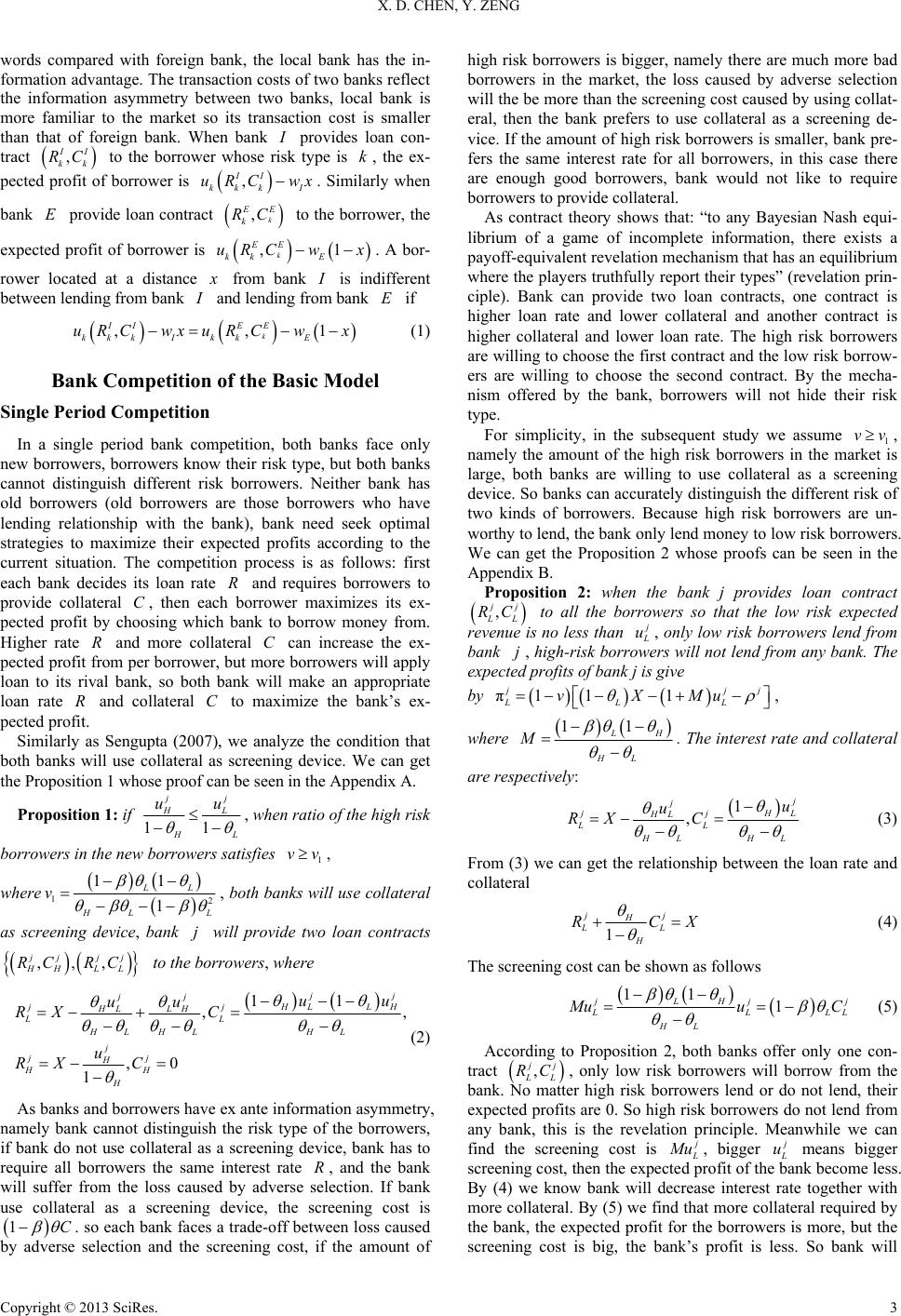 X. D. CHEN, Y. ZENG words compared with foreign bank, the local bank has the in- formation advantage. The transaction costs of two banks reflect the information asymmetry between two banks, local bank is more familiar to the market so its transaction cost is smaller than that of foreign bank. When bank provides loan con- tract I , I kk C to the borrower whose risk type is , the ex- k pected profit of borrower is , II kk I uRC wx k . Similarly when bank provide loan contract E ,k E k C to the borrower, the expected profit of borrower is E , k EE C1x kk uR w. A bor- rower located at a distance from bank is indifferent between lending from bank and lending from bank I I if ,, k II E kkkI kkE C wxuRCw x1 E uR (1) Bank Competition of the Basic Model Single Period Competition In a single period bank competition, both banks face only new borrowers, borrowers know their risk type, but both banks cannot distinguish different risk borrowers. Neither bank has old borrowers (old borrowers are those borrowers who have lending relationship with the bank), bank need seek optimal strategies to maximize their expected profits according to the current situation. The competition process is as follows: first each bank decides its loan rate and requires borrowers to provide collateral , then each borrower maximizes its ex- pected profit by choosing which bank to borrow money from. Higher rate C and more collateral can increase the ex- pected profit from per borrower, but more borrowers will apply loan to its rival bank, so both bank will make an appropriate loan rate C and collateral to maximize the bank’s ex- pected profit. C Similarly as Sengupta (2007), we analyze the condition that both banks will use collateral as screening device. We can get the Proposition 1 whose proof can be seen in the Appendix A. Proposition 1: if 11 jj HL L uu , when ratio of the high risk borrowers in the new borrowers satisfies , where 1 vv 12 11 1 LL LL v , both banks will use collateral as screening device, bank will provide two loan contracts ,, jj HH RC R, jj LL C to the borrowers, where 11 ,, ,0 1 j jj HL H jj HL LH LL HL HLHL j jj H HH H uu uu RX C u RX C L (2) As banks and borrowers have ex ante information asymmetry, namely bank cannot distinguish the risk type of the borrowers, if bank do not use collateral as a screening device, bank has to require all borrowers the same interest rate , and the bank will suffer from the loss caused by adverse selection. If bank use collateral as a screening device, the screening cost is 1C . so each bank faces a trade-off between loss caused by adverse selection and the screening cost, if the amount of high risk borrowers is bigger, namely there are much more bad borrowers in the market, the loss caused by adverse selection will the be more than the screening cost caused by using collat- eral, then the bank prefers to use collateral as a screening de- vice. If the amount of high risk borrowers is smaller, bank pre- fers the same interest rate for all borrowers, in this case there are enough good borrowers, bank would not like to require borrowers to provide collateral. As contract theory shows that: “to any Bayesian Nash equi- librium of a game of incomplete information, there exists a payoff-equivalent revelation mechanism that has an equilibrium where the players truthfully report their types” (revelation prin- ciple). Bank can provide two loan contracts, one contract is higher loan rate and lower collateral and another contract is higher collateral and lower loan rate. The high risk borrowers are willing to choose the first contract and the low risk borrow- ers are willing to choose the second contract. By the mecha- nism offered by the bank, borrowers will not hide their risk type. For simplicity, in the subsequent study we assume 1, namely the amount of the high risk borrowers in the market is large, both banks are willing to use collateral as a screening device. So banks can accurately distinguish the different risk of two kinds of borrowers. Because high risk borrowers are un- worthy to lend, the bank only lend money to low risk borrowers. We can get the Proposition 2 whose proofs can be seen in the Appendix B. vv Proposition 2: when the bank j provides loan contract , j L C to all the borrowers so that the low risk expected revenue is no less than u, only low risk borrowers lend from bank , high-risk borrowers will not lend from any bank. The expected profits of bank j is give by π11 1 jj LLL vXMu , where 11 LH HL M . The interest rate and collateral are respectively: 1 , j L jj HL LL HL HL u u RX C (3) From (3) we can get the relationship between the loan rate and collateral 1 jj H LL H CX (4) The screening cost can be shown as follows 11 1 LH jjj L HL LL uu C (5) According to Proposition 2, both banks offer only one con- tract , j L C, only low risk borrowers will borrow from the bank. No matter high risk borrowers lend or do not lend, their expected profits are 0. So high risk borrowers do not lend from any bank, this is the revelation principle. Meanwhile we can find the screening cost is u, bigger u means bigger screening cost, then the expected profit of the bank become less. By (4) we know bank will decrease interest rate together with more collateral. By (5) we find that more collateral required by the bank, the expected profit for the borrowers is more, but the screening cost is big, the bank’s profit is less. So bank will Copyright © 2013 SciRes. 3 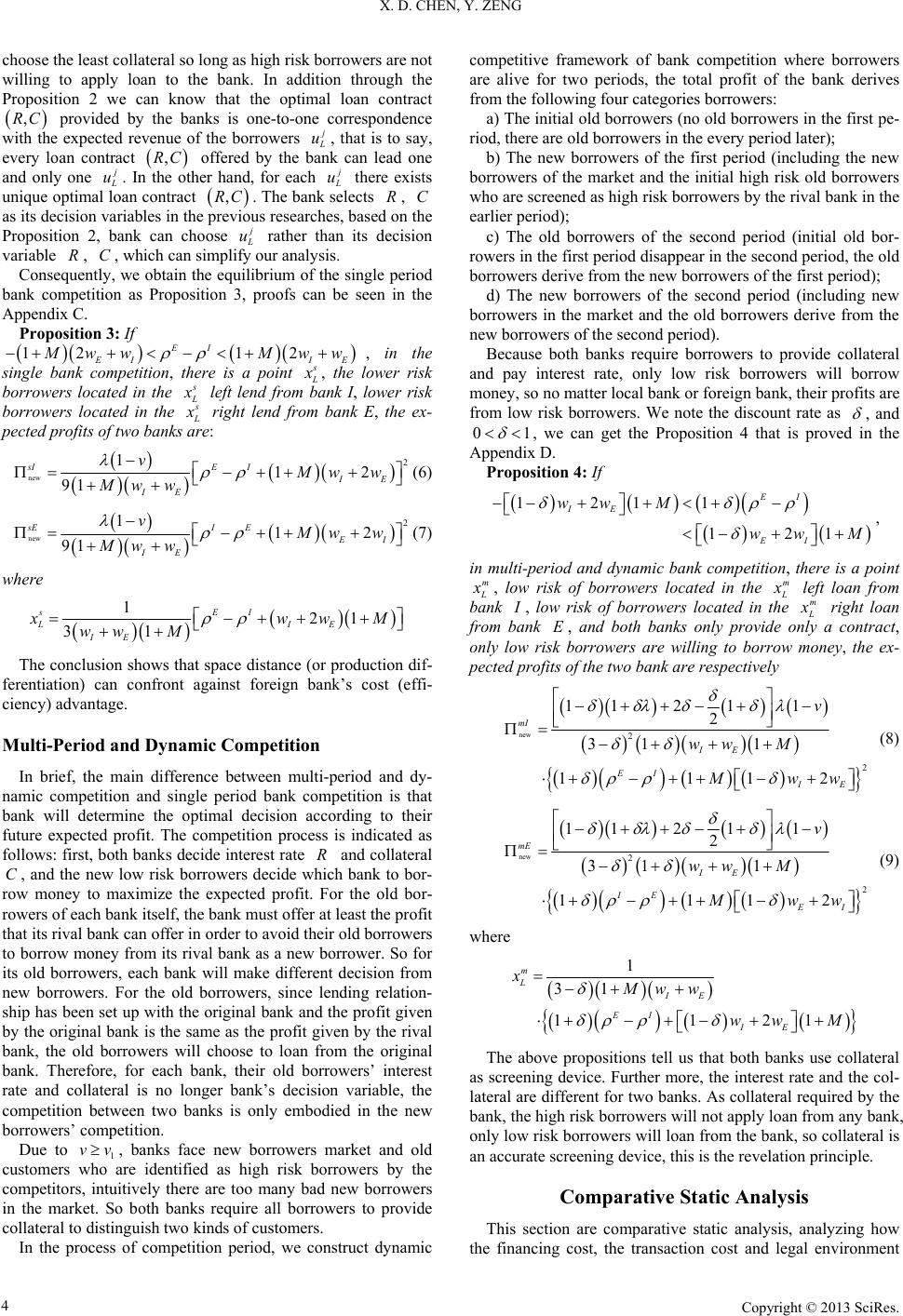 X. D. CHEN, Y. ZENG choose the least collateral so long as high risk borrowers are not willing to apply loan to the bank. In addition through the Proposition 2 we can know that the optimal loan contract provided by the banks is one-to-one correspondence with the expected revenue of the borrowers ,RC u, that is to say, every loan contract offered by the bank can lead one and only one ,RC u. In the other hand, for each u there exists unique optimal loan contract . The bank selects ,RC , as its decision variables in the previous researches, based on the Proposition 2, bank can choose C u rather than its decision variable , , which can simplify our analysis. C Consequently, we obtain the equilibrium of the single period bank competition as Proposition 3, proofs can be seen in the Appendix C. Proposition 3: If 12 12 EI IIE wwMww , in the single bank competition, there is a point , the lower risk borrowers located in the left lend from bank I, lower risk borrowers located in the right lend from bank E, the ex- pected profits of two banks are: Mw new sI 2 E w 1 12 I Mw 91 E I IE v w(6) Mw new sE 2 I w 1 12 E Mw 91 I E IE v w (7) where 21 w I 1 IE ww31 L x M sE I E w M The conclusion shows that space distance (or production dif- ferentiation) can confront against foreign bank’s cost (effi- ciency) advantage. Multi-Period and Dynamic Compet ition In brief, the main difference between multi-period and dy- namic competition and single period bank competition is that bank will determine the optimal decision according to their future expected profit. The competition process is indicated as follows: first, both banks decide interest rate and collateral , and the new low risk borrowers decide which bank to bor- row money to maximize the expected profit. For the old bor- rowers of each bank itself, the bank must offer at least the profit that its rival bank can offer in order to avoid their old borrowers to borrow money from its rival bank as a new borrower. So for its old borrowers, each bank will make different decision from new borrowers. For the old borrowers, since lending relation- ship has been set up with the original bank and the profit given by the original bank is the same as the profit given by the rival bank, the old borrowers will choose to loan from the original bank. Therefore, for each bank, their old borrowers’ interest rate and collateral is no longer bank’s decision variable, the competition between two banks is only embodied in the new borrowers’ competition. C Due to 1, banks face new borrowers market and old customers who are identified as high risk borrowers by the competitors, intuitively there are too many bad new borrowers in the market. So both banks require all borrowers to provide collateral to distinguish two kinds of customers. vv In the process of competition period, we construct dynamic competitive framework of bank competition where borrowers are alive for two periods, the total profit of the bank derives from the following four categories borrowers: a) The initial old borrowers (no old borrowers in the first pe- riod, there are old borrowers in the every period later); b) The new borrowers of the first period (including the new borrowers of the market and the initial high risk old borrowers who are screened as high risk borrowers by the rival bank in the earlier period); c) The old borrowers of the second period (initial old bor- rowers in the first period disappear in the second period, the old borrowers derive from the new borrowers of the first period); d) The new borrowers of the second period (including new borrowers in the market and the old borrowers derive from the new borrowers of the second period). Because both banks require borrowers to provide collateral and pay interest rate, only low risk borrowers will borrow money, so no matter local bank or foreign bank, their profits are from low risk borrowers. We note the discount rate as , and 01 , we can get the Proposition 4 that is proved in the Appendix D. Proposition 4: If 1211 121 EI IE EI ww M ww M , in multi-period and dynamic bank competition, there is a point m , low risk of borrowers located in the m left loan from bank , low risk of borrowers located in the Im right loan from bank , and both banks only provide only a contract, only low risk borrowers are willing to borrow money, the ex- pected profits of the two bank are respectively new 2 2 112 11 2 31 1 111 mI IE EI IE v ww M Mww 2 (8) new 2 2 112 11 2 31 1 111 mE IE IE EI v ww M Mww 2 (9) where 1 31 112 m L IE EI IE xMw w wwM 1 The above propositions tell us that both banks use collateral as screening device. Further more, the interest rate and the col- lateral are different for two banks. As collateral required by the bank, the high risk borrowers will not apply loan from any bank, only low risk borrowers will loan from the bank, so collateral is an accurate screening device, this is the revelation principle. Comparative Static Analysis This section are comparative static analysis, analyzing how the financing cost, the transaction cost and legal environment Copyright © 2013 SciRes. 4 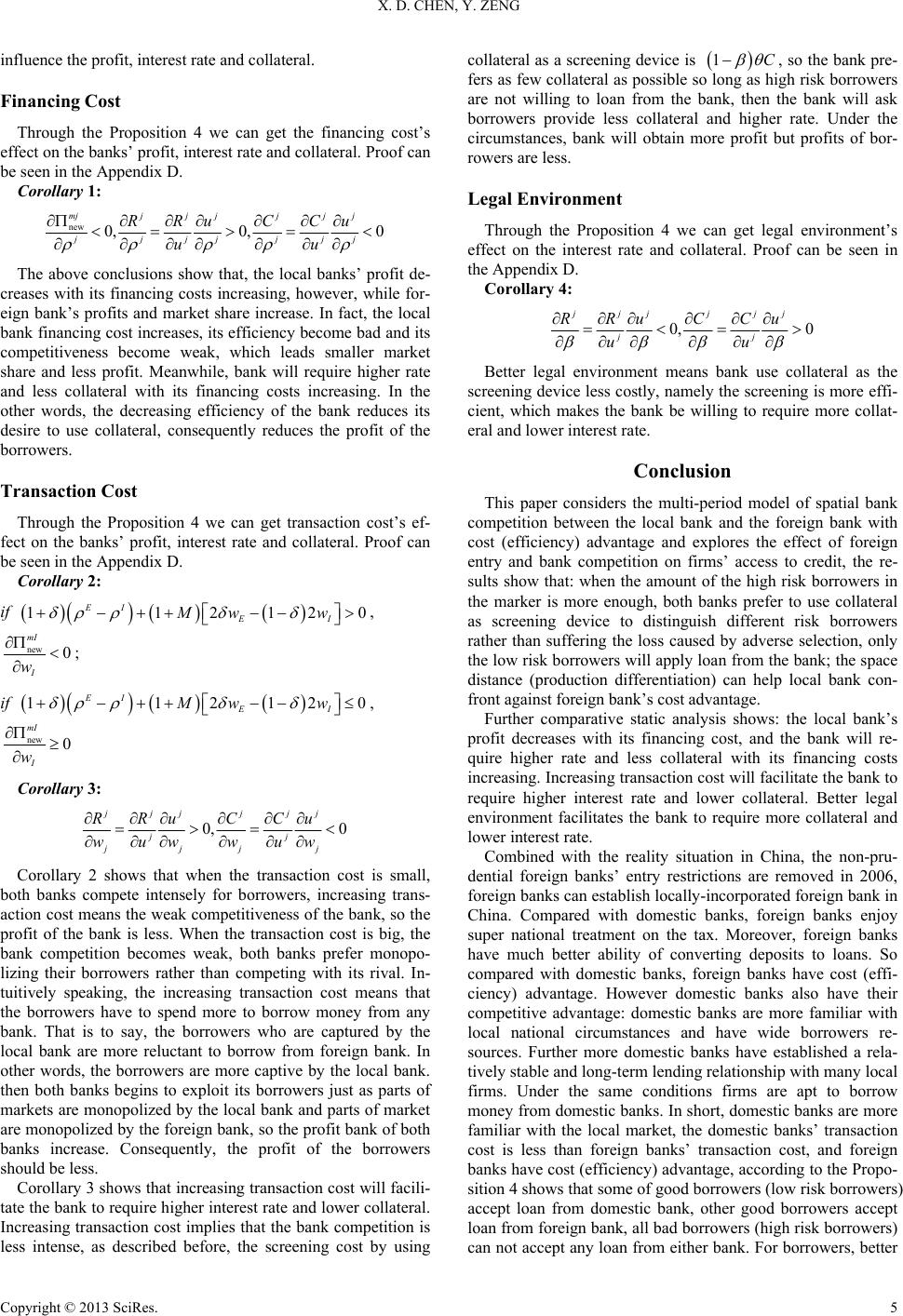 X. D. CHEN, Y. ZENG influence the profit, interest rate and collateral. Financing Cost Through the Proposition 4 we can get the financing cost’s effect on the banks’ profit, interest rate and collateral. Proof can be seen in the Appendix D. Corollary 1: new 0, 0,0 mjjjjjj j jjjjjjj RRuCCu uu The above conclusions show that, the local banks’ profit de- creases with its financing costs increasing, however, while for- eign bank’s profits and market share increase. In fact, the local bank financing cost increases, its efficiency become bad and its competitiveness become weak, which leads smaller market share and less profit. Meanwhile, bank will require higher rate and less collateral with its financing costs increasing. In the other words, the decreasing efficiency of the bank reduces its desire to use collateral, consequently reduces the profit of the borrowers. Transaction Cost Through the Proposition 4 we can get transaction cost’s ef- fect on the banks’ profit, interest rate and collateral. Proof can be seen in the Appendix D. Corollary 2: if 11212 EI EI Mw w 0 , new 0 mI I w ; if 11212 EI EI Mw w 0 , new 0 mI I w Corollary 3: 0, 0 jjjj jj jj jjj j RRu CCu wuw wuw Corollary 2 shows that when the transaction cost is small, both banks compete intensely for borrowers, increasing trans- action cost means the weak competitiveness of the bank, so the profit of the bank is less. When the transaction cost is big, the bank competition becomes weak, both banks prefer monopo- lizing their borrowers rather than competing with its rival. In- tuitively speaking, the increasing transaction cost means that the borrowers have to spend more to borrow money from any bank. That is to say, the borrowers who are captured by the local bank are more reluctant to borrow from foreign bank. In other words, the borrowers are more captive by the local bank. then both banks begins to exploit its borrowers just as parts of markets are monopolized by the local bank and parts of market are monopolized by the foreign bank, so the profit bank of both banks increase. Consequently, the profit of the borrowers should be less. Corollary 3 shows that increasing transaction cost will facili- tate the bank to require higher interest rate and lower collateral. Increasing transaction cost implies that the bank competition is less intense, as described before, the screening cost by using collateral as a screening device is 1C , so the bank pre- fers as few collateral as possible so long as high risk borrowers are not willing to loan from the bank, then the bank will ask borrowers provide less collateral and higher rate. Under the circumstances, bank will obtain more profit but profits of bor- rowers are less. Legal Environment Through the Proposition 4 we can get legal environment’s effect on the interest rate and collateral. Proof can be seen in the Appendix D. Corollary 4: 0, 0 jjjj jj jj RRu CCu uu Better legal environment means bank use collateral as the screening device less costly, namely the screening is more effi- cient, which makes the bank be willing to require more collat- eral and lower interest rate. Conclusion This paper considers the multi-period model of spatial bank competition between the local bank and the foreign bank with cost (efficiency) advantage and explores the effect of foreign entry and bank competition on firms’ access to credit, the re- sults show that: when the amount of the high risk borrowers in the marker is more enough, both banks prefer to use collateral as screening device to distinguish different risk borrowers rather than suffering the loss caused by adverse selection, only the low risk borrowers will apply loan from the bank; the space distance (production differentiation) can help local bank con- front against foreign bank’s cost advantage. Further comparative static analysis shows: the local bank’s profit decreases with its financing cost, and the bank will re- quire higher rate and less collateral with its financing costs increasing. Increasing transaction cost will facilitate the bank to require higher interest rate and lower collateral. Better legal environment facilitates the bank to require more collateral and lower interest rate. Combined with the reality situation in China, the non-pru- dential foreign banks’ entry restrictions are removed in 2006, foreign banks can establish locally-incorporated foreign bank in China. Compared with domestic banks, foreign banks enjoy super national treatment on the tax. Moreover, foreign banks have much better ability of converting deposits to loans. So compared with domestic banks, foreign banks have cost (effi- ciency) advantage. However domestic banks also have their competitive advantage: domestic banks are more familiar with local national circumstances and have wide borrowers re- sources. Further more domestic banks have established a rela- tively stable and long-term lending relationship with many local firms. Under the same conditions firms are apt to borrow money from domestic banks. In short, domestic banks are more familiar with the local market, the domestic banks’ transaction cost is less than foreign banks’ transaction cost, and foreign banks have cost (efficiency) advantage, according to the Propo- sition 4 shows that some of good borrowers (low risk borrowers) accept loan from domestic bank, other good borrowers accept loan from foreign bank, all bad borrowers (high risk borrowers) can not accept any loan from either bank. For borrowers, better Copyright © 2013 SciRes. 5 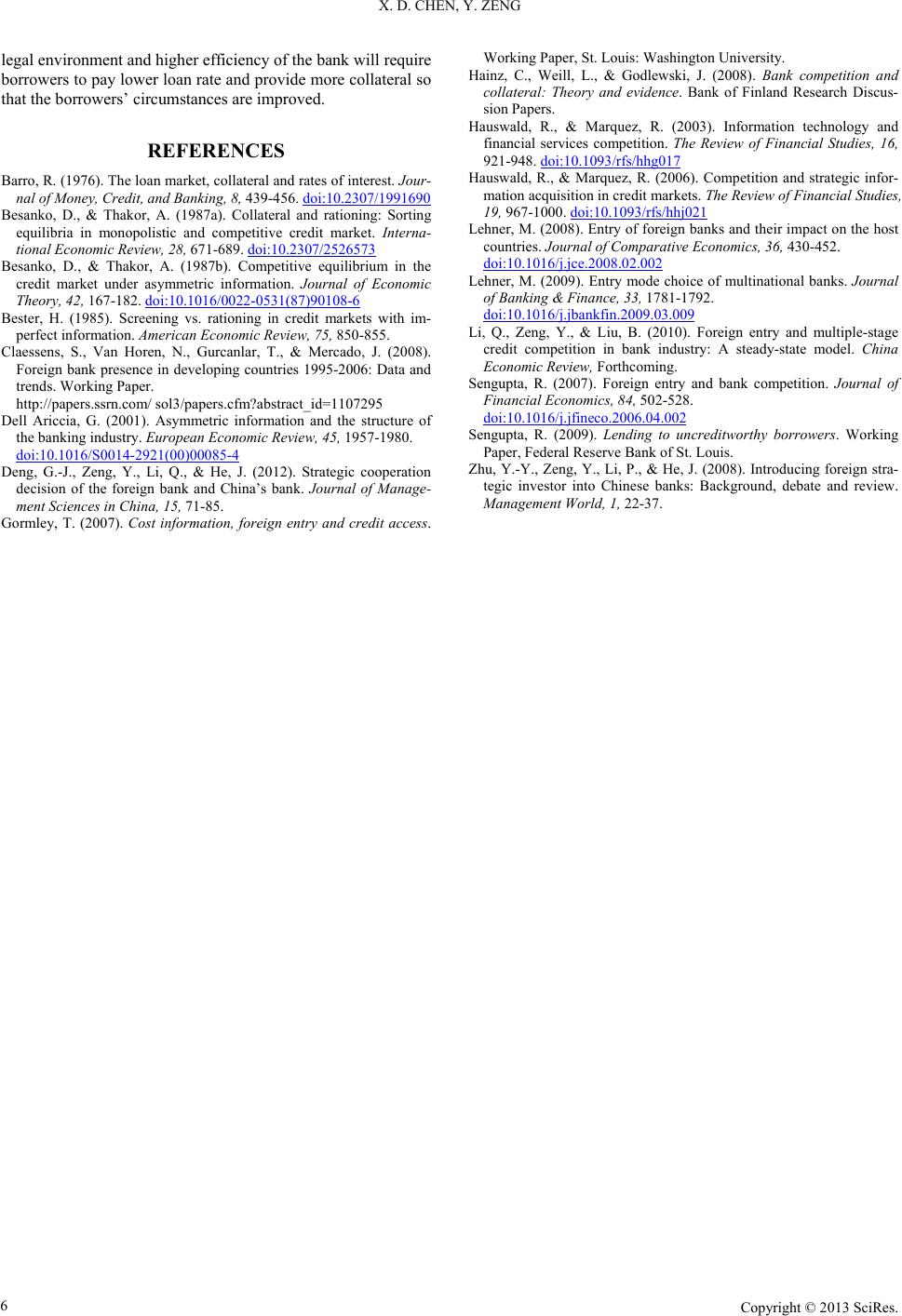 X. D. CHEN, Y. ZENG Copyright © 2013 SciRes. 6 legal environment and higher efficiency of the bank will require borrowers to pay lower loan rate and provide more collateral so that the borrowers’ circumstances are improved. REFERENCES Barro, R. (1976). The loan market, collateral and rates of interest. Jour- nal of Money, Credit, and Ba nk in g , 8, 439-456. doi:10.2307/1991690 Besanko, D., & Thakor, A. (1987a). Collateral and rationing: Sorting equilibria in monopolistic and competitive credit market. Interna- tional Economic Review, 28, 671-689. doi:10.2307/2526573 Besanko, D., & Thakor, A. (1987b). Competitive equilibrium in the credit market under asymmetric information. Journal of Economic Theory, 42, 167-182. doi:10.1016/0022-0531(87)90108-6 Bester, H. (1985). Screening vs. rationing in credit markets with im- perfect information. American Economic Review, 75, 850-855. Claessens, S., Van Horen, N., Gurcanlar, T., & Mercado, J. (2008). Foreign bank presence in developing countries 1995-2006: Data and trends. Working Paper. http://papers.ssrn.com/ sol3/papers.cfm?abstract_id=1107295 Dell Ariccia, G. (2001). Asymmetric information and the structure of the banking industry. European Economic Review, 45, 1957-1980. doi:10.1016/S0014-2921(00)00085-4 Deng, G.-J., Zeng, Y., Li, Q., & He, J. (2012). Strategic cooperation decision of the foreign bank and China’s bank. Journal of Manage- ment Sciences in China, 15, 71-85. Gormley, T. (2007). Cost information, foreign entry and credit access. Working Paper, St. Louis: Washington University. Hainz, C., Weill, L., & Godlewski, J. (2008). Bank competition and collateral: Theory and evidence. Bank of Finland Research Discus- sion Papers. Hauswald, R., & Marquez, R. (2003). Information technology and financial services competition. The Review of Financial Studies, 16, 921-948. doi:10.1093/rfs/hhg017 Hauswald, R., & Marquez, R. (2006). Competition and strategic infor- mation acquisition in credit markets. The Review of Financial Studies, 19, 967-1000. doi:10.1093/rfs/hhj021 Lehner, M. (2008). Entry of foreign banks and their impact on the host countries. Journal of Comparative Economics, 36, 430-452. doi:10.1016/j.jce.2008.02.002 Lehner, M. (2009). Entry mode choice of multinational banks. Journal of Banking & Finance, 33, 1781-1792. doi:10.1016/j.jbankfin.2009.03.009 Li, Q., Zeng, Y., & Liu, B. (2010). Foreign entry and multiple-stage credit competition in bank industry: A steady-state model. China Economic Review, Forthcoming. Sengupta, R. (2007). Foreign entry and bank competition. Journal of Financial Economics, 8 4, 502-528. doi:10.1016/j.jfineco.2006.04.002 Sengupta, R. (2009). Lending to uncreditworthy borrowers. Working Paper, Federal Reserve Bank of St. Louis. Zhu, Y.-Y., Zeng, Y., Li, P., & He, J. (2008). Introducing foreign stra- tegic investor into Chinese banks: Background, debate and review. Management World, 1, 22-37. 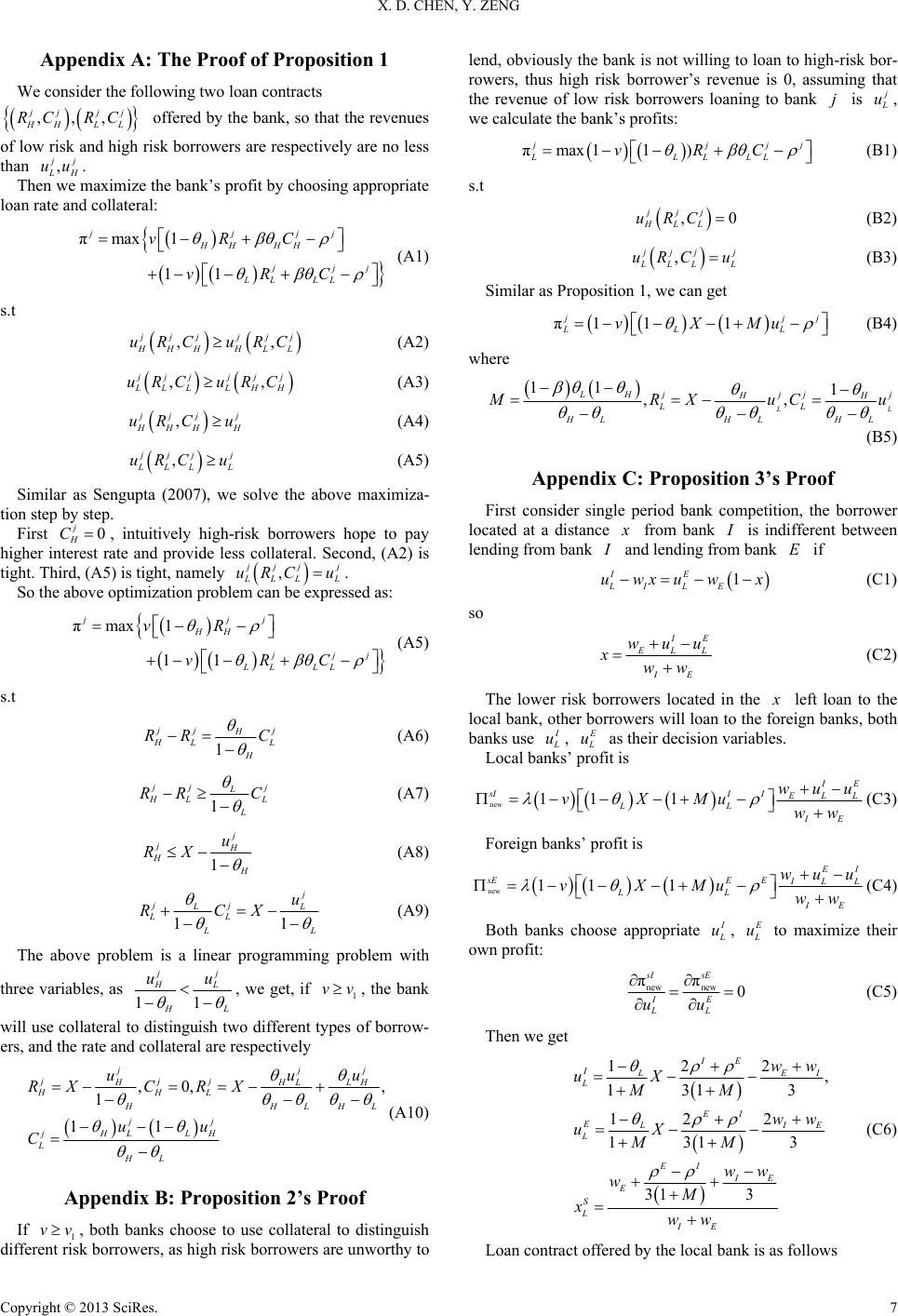 X. D. CHEN, Y. ZENG Appendix A: The Proof of Proposition 1 We consider the following two loan contracts ,,, jj jj HH LL RCRC offered by the bank, so that the revenues of low risk and high risk borrowers are respectively are no less than , j H uu. Then we maximize the bank’s profit by choosing appropriate loan rate and collateral: πmax 1 11 jjj HH HH jj LL LL vRC vRC j j (A1) s.t ,, jjjjj HHH LL uRCuRC (A2) ,, jjjjj LLLLHH uRC uRC (A3) , jj j HH H uRCu (A4) , jj j LL L uRC u (A5) Similar as Sengupta (2007), we solve the above maximiza- tion step by step. First H, intuitively high-risk borrowers hope to pay higher interest rate and provide less collateral. Second, (A2) is tight. Third, (A5) is tight, namely 0 j C , jj j LL L So the above optimization problem can be expressed as: uRC u. πmax 1 11 jjj HH jj LL LL vR vRC j (A5) s.t 1 j Hj L H L R C (A6) 1 j Lj L L L R C (A7) 1 j jH H u RX (A8) 11 j jj L LLL L u RCX (A9) The above problem is a linear programming problem with three variables, as 11 j HL j L uu , we get, if , the bank 1 vv will use collateral to distinguish two different types of borrow- ers, and the rate and collateral are respectively ,0, 1 11 jj jjj HHL HHL , j LH HL HL jj HL LH j L HL uu RXC RX uu C u (A10) Appendix B: Proposition 2’s Proof If 1 vv, both banks choose to use collateral to distinguish different risk borrowers, as high risk borrowers are unworthy to lend, obviously the bank is not willing to loan to high-risk bor- rowers, thus high risk borrower’s revenue is 0, assuming that the revenue of low risk borrowers loaning to bank is u, we calculate the bank’s profits: πmax11) jj LLLL vRC j L (B1) s.t , jjj HLL uRC0 (B2) , jj j LL L uRC u (B3) Similar as Proposition 1, we can get π111 j LL vXMu j L (B4) where 11 1 ,, L HL LH jjjj HH LL HL HL RX uC u (B5) Appendix C: Proposition 3’s Proof First consider single period bank competition, the borrower located at a distance from bank is indifferent between lending from bank and lending from bank if I I E 1 IE LIL E uwxuw x (C1) so E LL IE wuu xww (C2) The lower risk borrowers located in the left loan to the local bank, other borrowers will loan to the foreign banks, both banks use u, u as their decision variables. Local banks’ profit is new 111 E sII I L IE ww L LL wuu vXMu (C3) Foreign banks’ profit is new 11 1 I sEE E L IE ww L LL wu u vXMu (C4) Both banks choose appropriate u, u to maximize their own profit: new new ππ 0 sI sE IE LL uu (C5) Then we get 12 2 , 3 3 131 12 2 131 31 3 IE I EI L EI E I L EI IE E S L IE ww uX MM w uX MM ww wM xww E w (C6) Loan contract offered by the local bank is as follows Copyright © 2013 SciRes. 7 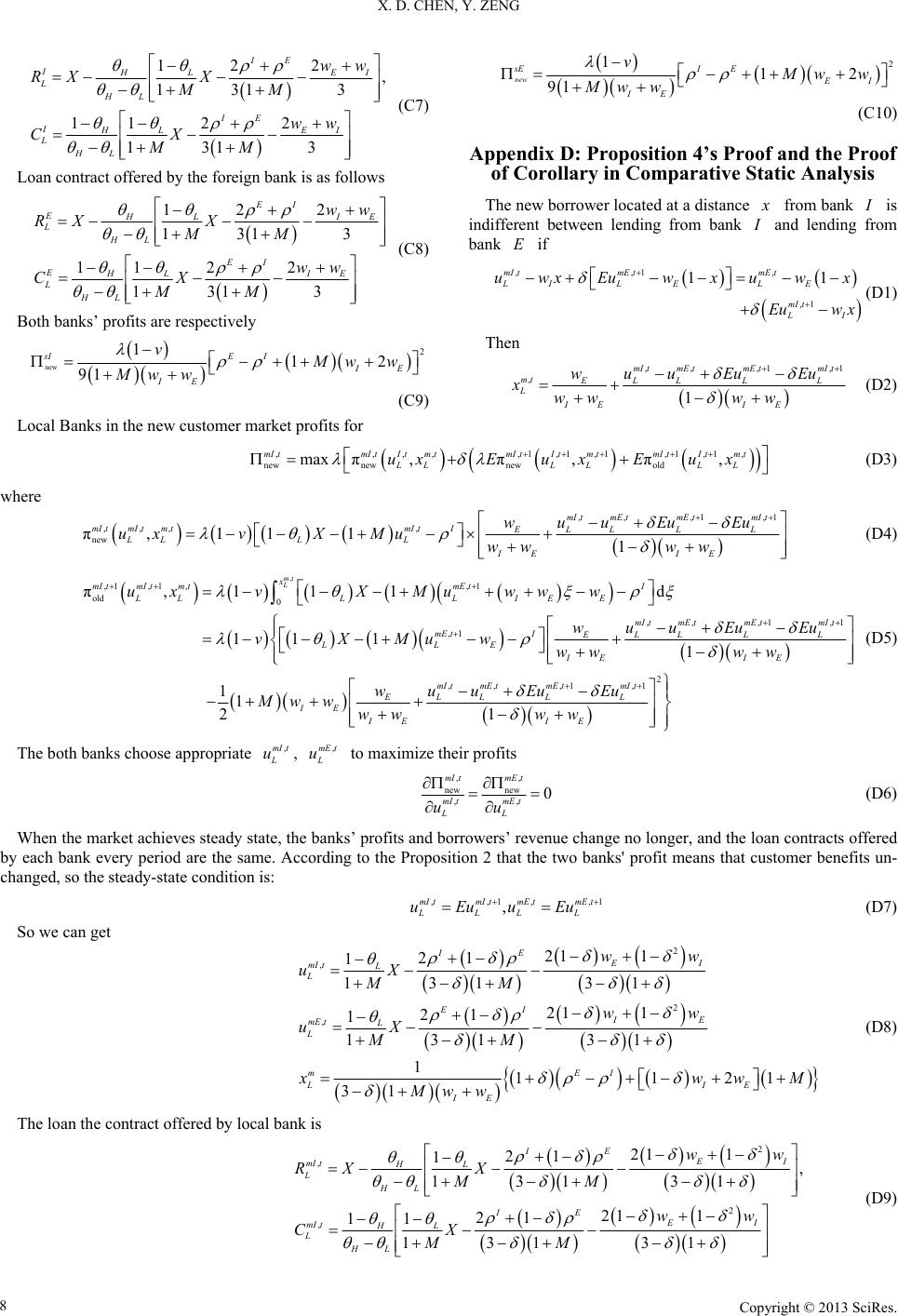 X. D. CHEN, Y. ZENG Copyright © 2013 SciRes. 8 12 2 , 131 3 11 22 131 3 IE IHL E L HL IE IHLEI L HL ww RX X MM ww CX MM I (C7) 2112 91 new sEI EEI IE vMww Mw w (C10) Appendix D: Proposition 4’s Proof and the Proof of Corollary in Comparative Static Analysis Loan contract offered by the foreign bank is as follows 12 2 131 3 11 22 131 3 EI EHL I L HL EI EHL IE L HL ww RX X MM ww CX MM E (C8) The new borrower located at a distance from bank is indifferent between lending from bank and lending from bank I I if ,,1 , ,1 11 mItmE tmE t LILEL E mI t LI uwxEu wxuwx uw x (D1) Both banks’ profits are respectively new 2112 91 sIE IIE IE vMw w Mw w (C9) Then , ,,1,1 , 1 mI tmEtmEtmIt mt ELL LL L IE IE wuu EuEu xww ww (D2) Local Banks in the new customer market profits for ,,,,,1 ,1 ,1,1 ,1 , new newnewold max π,π,π, mItmItItmtmIt ItmtmIt Itmt LLLL LL uxEuxEu x (D3) where , ,,1,1 ,,, , new π,11 11 mI tmE tmEtmI t mI tmI tmtmI tIELL LL LLL L IE IE wuu EuEu uxvX Muww ww (D4) , ,1,1 ,,1 old 0 ,,,1 , ,1 ,, π,1 11d 11 11 11 2 mt L x mI tmItmtmEtI LLLLIE E mI tmE tmE tmI t mE tIELL LL LLE IE IE mI tmE t ELL IE IE uxvXMuww w wuu EuEu vXMuw ww ww wuu Mw www 1 2 ,1 ,1 1 mE tmI t LL IE Eu Eu ww (D5) The both banks choose appropriate , to maximize their profits ,mI t L u,mEt L u ,, new new ,, 0 mI tmE t mI tmEt LL uu (D6) When the market achieves steady state, the banks’ profits and borrowers’ revenue change no longer, and the loan contracts offered by each bank every period are the same. According to the Proposition 2 that the two banks' profit means that customer benefits un- changed, so the steady-state condition is: ,,1, , mI tmItmEtmEt LLL L uEuuEu ,1 (D7) So we can get 2 , 2 , 21 1 21 1 131 31 21 1 21 1 131 31 1112 31 IE EI mI tL L EI IE mE tL L mEI LIE IE ww uX MM ww uX MM xw Mw w 1wM (D8) The loan the contract offered by local bank is 2 , 2 , 211 21 1, 131 31 211 21 11 131 31 IE EI mI tHL L HL IE EI mI tHL L HL ww RX X MM ww CX MM (D9) 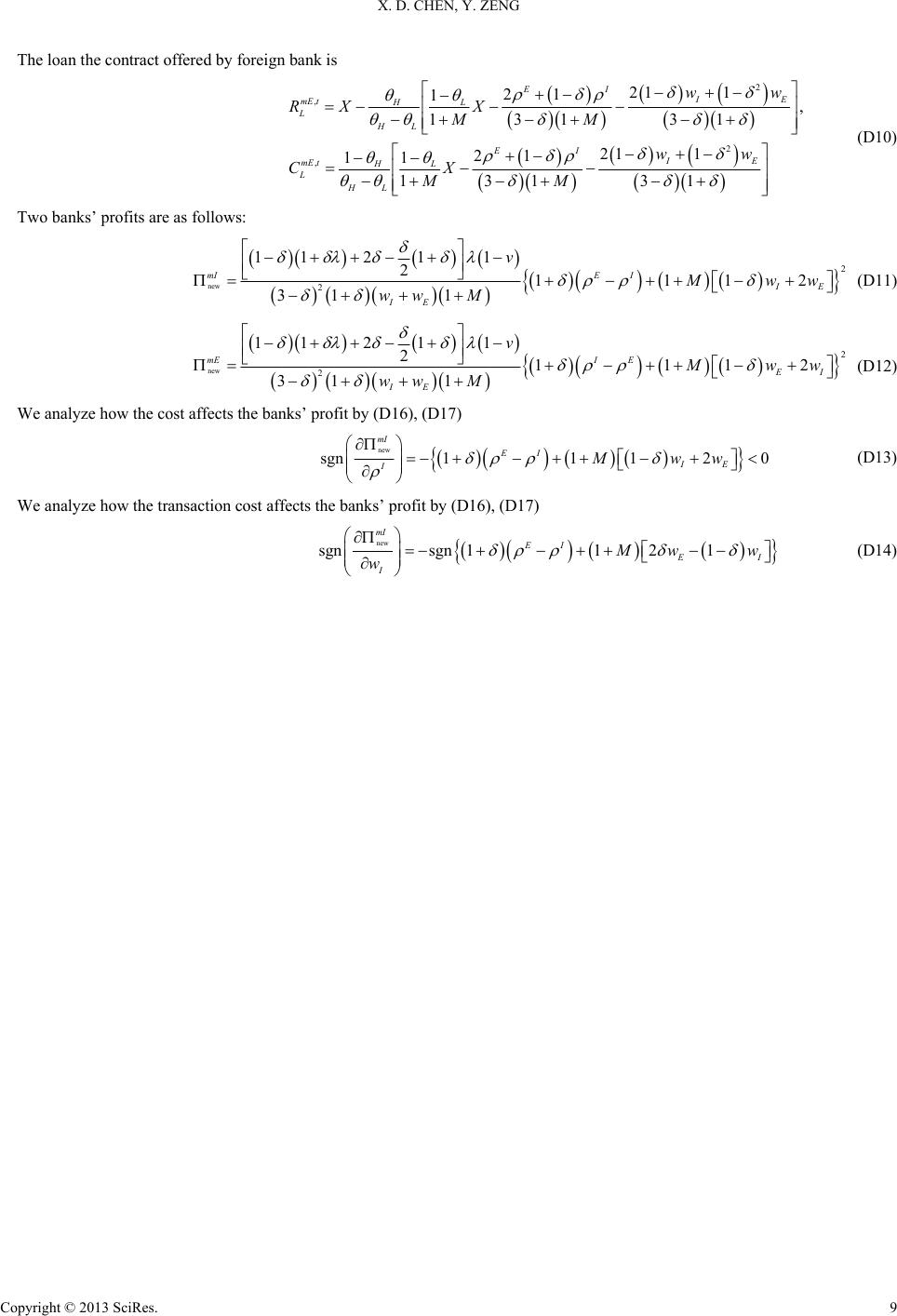 X. D. CHEN, Y. ZENG The loan the contract offered by foreign bank is 2 , 2 , 21 1 21 1, 131 31 21 1 21 11 131 31 EI IE mE tHL L HL EI IE mE tHL L HL ww RX X MM ww CX MM (D10) Two banks’ profits are as follows: new 2 2 112 11 21112 31 1 mI EI IE IE v Mww wwM (D11) new 2 2 112 11 2111 31 1 mE IE EI IE v Mww wwM 2 (D12) We analyze how the cost affects the banks’ profit by (D16), (D17) new sgn11120 mI EI IE IMww (D13) We analyze how the transaction cost affects the banks’ profit by (D16), (D17) new sgn sgn mI 11 21 EI EI I Mw w w (D14) Copyright © 2013 SciRes. 9
|